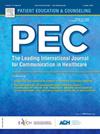在产前护理中黑人妇女的责备观念:一项混合方法研究
IF 2.9
2区 医学
Q2 PUBLIC, ENVIRONMENTAL & OCCUPATIONAL HEALTH
引用次数: 0
摘要
目的有证据表明,在与黑人妇女的临床接触中,产前保健提供者可能不成比例地将不良妊娠和分娩结果归因于个人层面的因素,而不是引用种族主义形成美国孕产妇健康不平等的复杂机制。这种关注延续了一种错误的说法,即黑人女性应对自己面临的风险负责,这可能会导致一种责备的感觉。本混合方法研究的目的是探讨黑人妇女产前护理中与指责相关的沟通经验。方法本研究的数据来自于黑人妇女产前护理经历的横断面混合方法研究,包括关于怀孕风险和责备的沟通。责备是通过调查和访谈问题来衡量的,这些问题评估了人们对责备、风险暴露和妊娠并发症的沟通反应。专题分析用于分析访谈数据(N = 17),并探讨减轻责备情绪的策略。混合方法分析比较了调查和访谈数据中责备经历的一致性。结果9名(53 %)的参与者在产前护理过程中感到自责。发展了四个主题,确定了责备的经历和通过沟通实践减轻责备的反应。混合方法的结果描述了定性和定量方法之间的差异,以及提供者的行为和自责如何引起对不良妊娠条件的内在化指责。结论:当提供者的沟通侧重于个人层面的因素,而排除了关于结构和人际种族主义在塑造妊娠健康中的作用的讨论时,参与者会感到责备。高水平的调查和访谈责备数据不一致表明,定量责备措施不能充分捕捉到产前护理期间的责备经历。实践意义提出了两种可能减少产前护理中责备的沟通方法:关于种族主义与健康之间关系的直接沟通,以及在出现意外并发症时告诉患者“这不是你的错”。本文章由计算机程序翻译,如有差异,请以英文原文为准。
Perceptions of blame among black women during prenatal care: A mixed methods study
Objective
There is evidence that prenatal health care providers may disproportionately attribute adverse pregnancy and birth outcomes to individual-level factors during clinical encounters with Black women, as opposed to citing the complex mechanisms by which racism shapes maternal health inequities in the US. This focus perpetuates the false narrative that Black women are responsible for their exposure to risks, potentially resulting in feelings of blame. The purpose of this mixed methods study was to explore experiences of blame-related communication during Black women’s prenatal care encounters.
Methods
Data for this study come from a cross-sectional, mixed methods study of Black women’s prenatal care experiences, including communication about pregnancy risks and blame. Blame was measured with survey and interview questions which assessed responses to communication about blame, exposure to risks, and pregnancy complications. Thematic analysis was used to analyze interview data (N = 17) that also explored strategies for alleviating feelings of blame. Mixed methods analysis compared congruency in blame experiences across survey and interview data.
Results
Nine (53 %) participants described experiencing blame during prenatal care. Four themes developed that identified experiences of blame and responses to blame-alleviation through communication practices. Mixed methods results describe differences across qualitative and quantitative approaches and how provider-perpetrated and self-blame give rise to internalized blame for adverse pregnancy conditions.
Conclusions
Participants perceived blame when provider communication focused on individual-level factors and excluded discussion about the role of structural and interpersonal racism in shaping pregnancy health. High levels of survey and interview blame data incongruency suggest that quantitative blame measures inadequately capture experiences of blame during prenatal care.
Practice Implications
Two communication practices that may reduce blame during prenatal care are proposed: direct communication about the relationship between racism and health, and telling patients, “it’s not your fault,” when unexpected complications arise.
求助全文
通过发布文献求助,成功后即可免费获取论文全文。
去求助
来源期刊

Patient Education and Counseling
医学-公共卫生、环境卫生与职业卫生
CiteScore
5.60
自引率
11.40%
发文量
384
审稿时长
46 days
期刊介绍:
Patient Education and Counseling is an interdisciplinary, international journal for patient education and health promotion researchers, managers and clinicians. The journal seeks to explore and elucidate the educational, counseling and communication models in health care. Its aim is to provide a forum for fundamental as well as applied research, and to promote the study of organizational issues involved with the delivery of patient education, counseling, health promotion services and training models in improving communication between providers and patients.
 求助内容:
求助内容: 应助结果提醒方式:
应助结果提醒方式:


